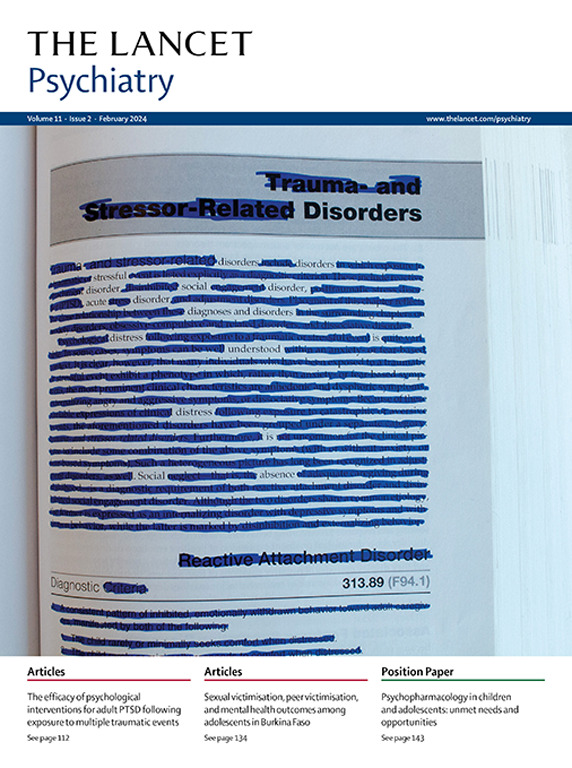德国边缘型人格障碍患者的数字治疗(EPADIP-BPD):一项实用、评估盲、平行组、随机对照试验
IF 30.8
1区 医学
Q1 PSYCHIATRY
引用次数: 0
摘要
背景:只有不到25%的边缘型人格障碍(BPD)患者接受了遵循指南的心理治疗。数字疗法可以帮助缩小这一差距。因此,我们测试了priovi的有效性和安全性,这是一种BPD的数字治疗方法。方法:我们进行了一项实用、评估盲、平行组、随机对照试验,根据DSM-5分类,通过德国的在线广告招募了23项边缘性症状列表(BSL-23)中至少中度严重程度的BPD患者。患者年龄在18岁或以上,同意自杀危机应急计划,并知情同意参与。如果患者最初诊断为物质使用障碍或诊断为精神障碍,则将其排除在外。简单的计算机抛硬币随机化(1:1)没有分层,将患者分配到基于图式治疗的无指导数字治疗和常规治疗(TAU;干预组)或单独TAU(对照组),研究调查人员在主要结局和主要安全结局分析后才进行分组分配。所有病人都可以使用任何形式的常规护理。对照组接受免费提供的针对bpd的自助材料。主要终点是意向治疗样本在3个月时治疗相互作用的时间,用BSL-23评分测量。安全性通过严重不良事件(即自杀未遂、其他危及生命的事件和住院)的数量来确定,并通过在线问卷进行评估。BPD患者参与了数字治疗的开发,但没有参与这项研究的设计。该试验已在德国临床试验注册(DRKS00028888)上注册并完成。在2022年5月3日至10月20日期间,对1766例患者进行了资格筛选,580例患者(520例[90%]女性,47例[8%]男性,13例[2%]性别不同)被随机分配到干预组(n=302)和对照组(n=278)。种族数据未被记录。在主要时间点3个月时,干预组有35例(12%)患者退出,对照组有15例(5%)患者退出。患者的中位年龄为29岁(IQR 24-37)。线性混合模型的意向治疗分析显示,干预组在3个月时治疗相互作用的时间显著延长(p= 0.0005) (d= 0.24 [95% CI 0.07 - 0.42])。在安全性方面,干预组(n=7)的自杀企图明显少于对照组(n=21);发病率比0.34 [95% CI 0.14 - 0.79];P = 0.0081),其他严重不良事件差异无统计学意义。本试验提供了初步证据,证明数字疗法priovi在治疗bpd个体方面的有效性和安全性问题。本文章由计算机程序翻译,如有差异,请以英文原文为准。
A digital therapeutic for people with borderline personality disorder in Germany (EPADIP-BPD): a pragmatic, assessor-blind, parallel-group, randomised controlled trial
Background
Fewer than 25% of patients with borderline personality disorder (BPD) receive guideline-adherent psychotherapy. Digital therapeutics can help reduce this gap. Therefore, we tested the effectiveness and safety of priovi, a digital therapeutic for BPD.Methods
We conducted a pragmatic, assessor-blind, parallel-group, randomised controlled trial, recruiting patients with BPD, according to DSM-5 classification, of at least moderate severity on the 23-item Borderline Symptom List (BSL-23) via online advertisements in Germany. Patients were aged 18 years or older, agreed on an emergency plan for suicidal crises, and gave informed consent to participate. Patients were excluded if they had a primary diagnosis of a substance use disorder or a diagnosis of a psychotic disorder. Simple computerised coin-toss randomisation (1:1) without stratification was used to assign patients to either the unguided digital therapeutic based on schema therapy together with treatment as usual (TAU; intervention group) or TAU alone (control group) and study investigators were masked to group assignment until after the analysis of the primary outcome and main safety outcome. All patients could use any form of usual care. The control group received freely available BPD-specific self-help material. The primary outcome was the time by treatment interaction in the intention-to-treat sample at 3 months measured by BSL-23 score. Safety was established via the number of serious adverse events (ie, suicide attempts, other life-threatening events, and hospitalisation), assessed via online questionnaire. Individuals with BPD were involved in the development of the digital therapeutic, but not in the design of this study. The trial was registered on German Clinical Trials Register (DRKS00028888) and is completed.Findings
Between May 3 and Oct 20, 2022, 1766 patients were screened for eligibility and 580 patients (520 [90%] women, 47 [8%] men, and 13 [2%] gender diverse) were randomly assigned to the intervention group (n=302) and control group (n=278). Ethnicity data were not recorded. At the primary timepoint of 3 months, 35 (12%) patients dropped out of the intervention group and 15 (5%) of the control group. The median age of patients was 29 years (IQR 24–37). Intention-to-treat analysis with linear mixed models showed a significant time by treatment interaction (p=0·0005) at 3 months in favour of the intervention group (d=0·24 [95% CI 0·07–0·42]). Regarding safety, there were significantly fewer suicide attempts in the intervention group (n=7) than in the control group (n=21; incidence rate ratio 0·34 [95% CI 0·14–0·79]; p=0·0081) and there were no differences regarding other serious adverse events.Interpretation
This trial provides tentative evidence of the effectiveness and absence of safety concerns of the digital therapeutic, priovi, in the treatment of individuals with BPD.Funding
GAIA.求助全文
通过发布文献求助,成功后即可免费获取论文全文。
去求助
来源期刊

Lancet Psychiatry
PSYCHIATRY-
CiteScore
58.30
自引率
0.90%
发文量
0
期刊介绍:
The Lancet Psychiatry is a globally renowned and trusted resource for groundbreaking research in the field of psychiatry. We specialize in publishing original studies that contribute to transforming and shedding light on important aspects of psychiatric practice. Our comprehensive coverage extends to diverse topics including psychopharmacology, psychotherapy, and psychosocial approaches that address psychiatric disorders throughout the lifespan. We aim to channel innovative treatments and examine the biological research that forms the foundation of such advancements. Our journal also explores novel service delivery methods and promotes fresh perspectives on mental illness, emphasizing the significant contributions of social psychiatry.
 求助内容:
求助内容: 应助结果提醒方式:
应助结果提醒方式:


